Want to make the most out of mealtime with your kid and have them eating well and trying new foods? I thought so. Check out these 7 insider tips to try today…
Who doesn’t love some down-right simple hacks to get your kid eating different food, and to decrease any stress you’re having at meals with your child? Over the last year, we started sharing some powerful tips on Instagram, and our followers kept asking for more.
These graphics and quick tips are easy. But, they’re also powerful. We’ve loved reading the comments about kids trying new foods and parents relief that dinnertime went smoothly for once.
So, we realized we needed to share the best of these simple tips and hacks with YOU too, although you should come hang out with us on Insta too because we have more tips and tricks up our sleeves to share.
Will These Tips Work for Picky Eaters? Even, REALLY Picky Eaters?
As an occupational therapist specializing in feeding, I’ll be the first to tell you that even 7 really good picky eating tips won’t fix all your picky eating woes. But, they can help your child start to feel more comfortable around new and different foods. When you use them consistently, they may learn to eat and enjoy more food!
I really get how disheartening and hopeless it can be when your child only eats a few foods. That’s well beyond the average picky eater that doesn’t like broccoli or lasagna.
Yet, progress is possible even with the pickiest of eaters, these tips will absolutely be beneficial for them.
7 Things to Try at Dinner to Get Your Kid Eating More
One thing I know is that parents aren’t taught a lot about feeding their kids. As a result, your left to figure out for yourself the best way to encourage your child to eat more. Often relying on your own experiences of your parents feeding you.
Totally understandable since such little information is shared with parents. Because of that, it’s easy to slip into habits and routines that actually can make your child’s eating worse. Or, at least not help it very much.
These 7 tips are designed to show you what to try instead…
Tip #1: Instead of asking your child to eat, try describing it’s texture and flavor!
It seems so frustrating when your child won’t try a food, especially when they’re picky and only eat a few foods. What’s wrong with asking “Can you try it?”
This simple question puts a lot of pressure on a child. They’re likely nervous about tasting the food and then they feel like they’re under a microscope, which means they’re less likely to try it.
Many kids will often happily take the opportunity to say “no” as well!
Instead of asking them to try a food, describe the texture and taste. If they’re nervous about the chicken nuggets, but they like other types of bread and crunchy foods, draw a connection for them by saying, “The chicken nuggets are crunchy on the outside like crackers, but have a flavor similar to bread.”
They may not immediately eat it, but now you’ve given them something constructive to think about. You’ve given them information that will likely help them try a bite without you having to ask.
Tips #2: Instead of rewarding with candy or dessert, try serving it no matter what
I know this might sound crazy, but we know from Ellyn Satter’s research that rewarding or bribing with candy or treats only teaches kids to desire and prefer the treats and candy more! Instead, level the playing field. Equalize dessert by serving it no matter what!
Keep in mind that you don’t have to serve dessert every night either. If you feel like your child is just going to wait for dessert, let them know it’s not an every night thing, so they shouldn’t count on it.
Read more tips for serving dessert to picky eaters in How to Handle Dessert with Picky Eaters.
Tip #3: Instead of letting your child have a snack before a meal, try redirecting them
Dinner is an hour away and your child is whining and throwing a fit because they’re starving. Not surprising, since they didn’t each much of the snack you provided 2 hours ago. You can’t stand the whining, so you give them a handful of crackers to hold them over. Seems innocent enough, but even a small amount of food can wreck their appetite.
Your child’s stomach is only the size of their fist, it doesn’t take much to fill it. And, a lot of kids, picky eater or not, will not eat unless they feel hungry. As adults, we eat when somebody gives us food. Kids often won’t do that.
Instead, give them some water and redirect them. The water will help fill up their belly enough to hold them over, but it won’t ruin their appetite. Milk or even juice can ruin an appetite though. Reassure them that dinner/lunch or whatever meal they’re waiting for is coming soon, then get them involved in an activity or the whining will likely continue.
For younger kids, act really excited about something they can play with or do with you. Once their mind is on something else, and they’ve had that water, they can usually handle waiting. For older kids, offer choices or have some special activities tucked away for when this moment arises!
Tips #4: Instead of serving a casserole, try serving buffet style
Casseroles are so tough for kids with all the mixed ingredients! But, that doesn’t mean you can’t still enjoy them. As you cook, keep some of the ingredients separate, and serve them alongside of the casserole. Kids are way more likely to take some plain noodles and some crumbled meat on the side than eat a piece of lasagna where it’s all mixed together!
Learn 2 other ways to serve casseroles in How to Get Kids to Eat Casseroles and Mixed Foods
Tip #5: Instead of asking, “Do you like it?”, try describing the texture
It seems like a simple question, “Do you like it?” But, it’s something I never ask kids, especially picky eaters, because it gives them the chance to say: “no”, which they likely will say. Asking this question puts the ball totally in your child’s court and they know it. They will take the opportunity to take control of the situation, feel some sense of control, and then never eat it again.
It doesn’t matter if your child likes it or not. More importantly, they don’t even know if they like it or not, if they’ve only had it 1-2 times. Remember, kids need to try food many times before they know if they like it or not.
And, picky eaters usually need even more exposures because they’re often sensitive to flavors and textures. Repeated exposure has to happen before they can get used to the texture and taste of the peanuts. After they’ve chewed and swallowed it 20 times, then they might really know if they like it.
But, they’re also kids, and their tastes and preferences can definitely change over time.
When you ask your child if they like it or not, it sort of closes the door. They start to put all foods into two categories: like and don’t like. And, it’s really hard to move a food out of the “don’t like” category, into the “like” category.
Instead, describe the food, which not only gives you something else to say, but helps them understand the food their unwilling to try. Even better is if you can relate it to something they usually eat!
Tip #6: Instead of cooked veggies, try frozen
This one works particularly well with peas, as long as your child doesn’t refuse cold foods, which some picky eaters do. The frozen pea is nearly tasteless and texture less. It’s like a smooth tiny little ice cube, yet it has all the nutrition!
I like to pull out a small bowl of frozen peas when I’m cooking dinner and the kids are hovering in the kitchen. I don’t say much about them, unless they don’t notice them, then I might say, “Check out those peas, they’re very cold. Some people eat them that way, they taste like little ice cubes.”
You can try frozen corn, and anything else your child is interested in. Frozen fruits like blueberries and mango can work really well too!
Tip #7: Instead of the clean plate club, try serving food family style
The clean plate club is an old school strategy parents use to get their kids to eat all the food on their plate. Unfortunately, now we know that teaches kids to ignore their natural body signs that they’re full and overeat. Those habits become ingrained and can last a lifetime!
Not to mention that we often put way to much food on our kid’s plates because we want them to eat as much as possible.
When we give our kids a sense of control by serving foods family style, this gives them a chance to interact with the food and take as small of a serving as they want. They can always get more food if they need it, but aren’t overwhelmed by a large portion.
If you’re overwhelmed at the thought of serving food family style with all the extra dishes, you can leave it in the pots and bring those right to the table, or put the food in storage containers so the leftovers can go right into the fridge afterwards!
Get Some Meal Ideas for Picky Eaters
You have some easy things to start working on, but you might need some food ideas for your picky eater too. Want to get a couple pages of meals that were specifically designed for picky eaters? Click the link below to get it right in your inbox!
Click here to get the Picky Eater Meal Ideas Printable
More Tips for Feeding Kids
How to Get Kids to Eat Healthy When They Won’t Eat Anything But Junk Food
7 Questions From Parents of Picky Eaters: Answered by a Feeding Therapist
How to Prevent Siblings From Becoming Picky Eaters, Too
Alisha Grogan is a licensed occupational therapist and founder of Your Kid’s Table. She has over 15 years experience with expertise in sensory processing and feeding development in babies, toddlers, and children. Alisha also has 3 boys of her own at home. Learn more about her here.
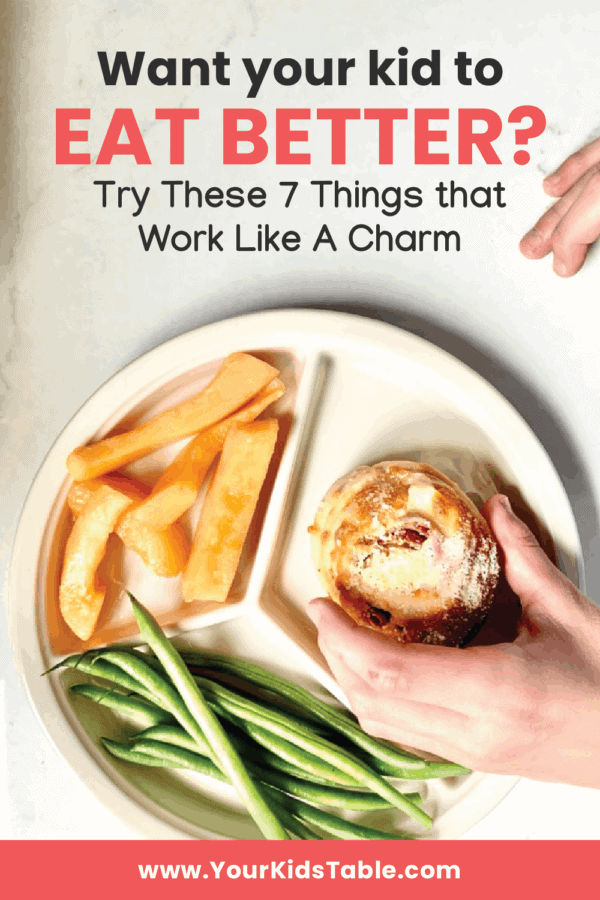
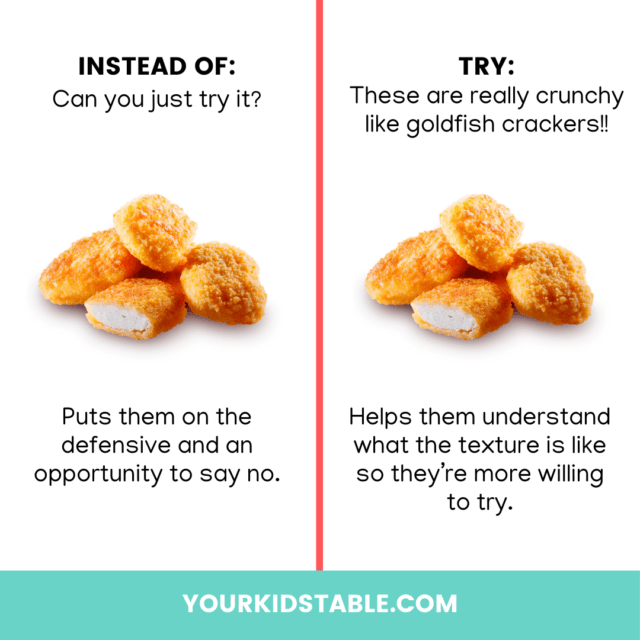

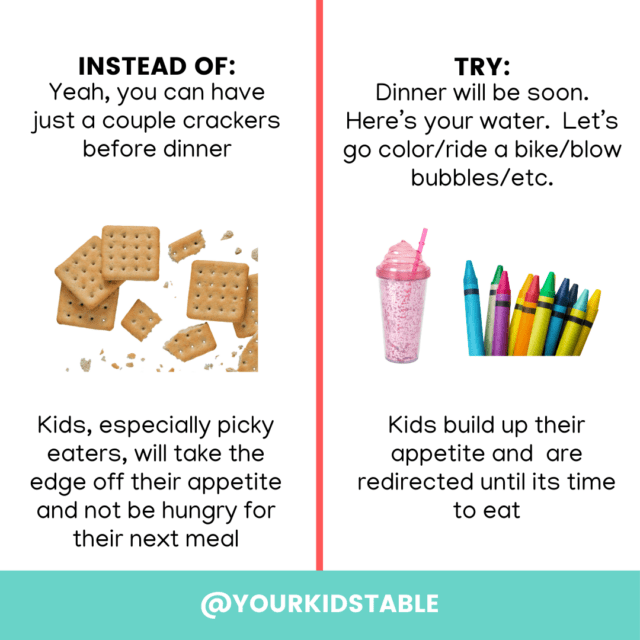
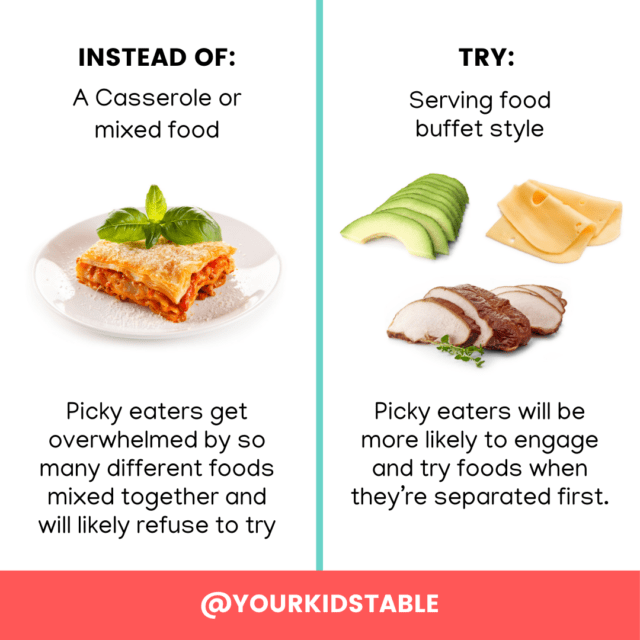

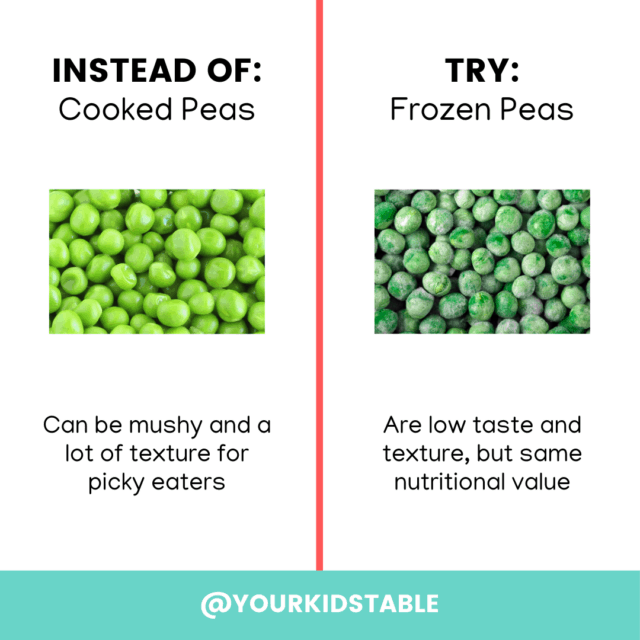

I have a question…what do you do if your child will not eat anything on their plate? We’ve tried everything and he just won’t eat it! Macaroni and cheese, carrots and 1 star chicken nugget.
Nothing new but if we give him something we know he will eat he would eat.
Hi Dee,
I would definitely start by maximizing variety within the preferred foods. A way to start this is through food chaining. But also changing up the presentation, brand, dips, etc. of what he currently prefers is another way to start. If you haven’t already, check out our free picky eating workshop.
Best,
Laura
Your Kid’s Table OT
These are brilliant, thank you!!
I also have a hack of my own! My daughter aged 3 has many sensory issues with foods. What helped us a lot was that I told her that anything on her plate that she doesn’t want to eat she should feed me. Before we started this strategy, she would just sit in front of her plate at times, refusing to even have a taste, unable to explain what the problem was. Now she will happily tuck in and if there is any problematic bite she will just feed me with it. Sometimes she explains why she does not like that particular bite which is very enlightening. I always take it with a thank you and eat it with a comment like: mmm that was delicious, I love the way this piece of meat was roasted on one side and soft on the other etc. At the end of the meal, her plate is cleared which gives her a sense of achievement – and I know she isn’t overfed nor hungry. Also, she has to manipulate all of the food on her plate, even the “scary” bites, which is an important sensory and fine motor exercise for her – before she would be giving out just because a particular food was on her plate and refuse to touch it, now she happily engages with it by feeding me and that way gets more familiar with it and hearing all the positive comments from me about the food really encourages her to try it.
Hey Marta,
Thanks so much for sharing with us! This is huge that she is engaging and touching of the foods she doesn’t want to eat and so great that you describe it for her! Great work!
Best,
Desiree
I agree that #3 is the hardest because I am in the middle of making the food. Older kids are just straight up told, no, they can wait. Younger kids I usually say that they can eat a plain carrot or serve up a dish of frozen veggies. Then at least they are getting some good stuff if they don’t eat my main meal.
Along with #5, we have a family rule that you can’t say you don’t like something unless you can describe why you don’t like it. We’ve gotten to the point where they will usually take at least one tiny taste, and then we help the kids talk about the texture, flavor, color, temperature, etc and what they didn’t like. They also have to share what they think would make it more palatable- change an ingredient, blending it, chopping it smaller or bigger, etc. This has really been a game changer for us.
#5 Yeah, casseroles never enter our door. I hate those articles titled “10 Easy Recipes All Kids Love” because they are always a list of casseroles.
Glad you found what works for you, with the re-directing you can also get them involved in helping in the kitchen which is great to get them touching and exploring the foods. But we do love the frozen veggies as well.
Best,
Desiree
I just love all the ideas and the moms that try so hard to make sure the kids are happy and well fed. I want to thank you the person that coaches us. I am actually a grandmother that has cooked for my granddaughter since she was little. She is a highly sensitive child so I have to be very gentle with the food subject.
You are so welcome! Thanks for your feedback and sharing with us!
Best,
Desiree
On #3, the problem is that if you could go play with the child, you probably wouldn’t be dealing with them whining about hunger in the first place. If it’s almost dinnertime, the parent in the scenario is probably in the middle of trying to cook something and is not free to go play. Suggestions for how to get toddlers and young kids to do an independent activity nearby would likely be more useful for many parents, I would think. I know that’s been a huge struggle at times with my own child.
You can try to get them involved with the mealtime making process as well, think washing, sorting, etc. This is also great for picky eaters. Some toddlers would do well just being in the kitchen with you for an activity which is another option letting them explore some of the items you are making for dinner with some toys can be a great way to interact (ie: broccoli trees for the dinosaurs, carrot road for cars, etc).
Hope that helps.
Best,
Desiree